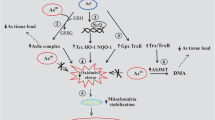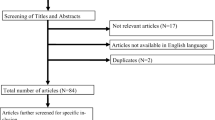Abstract
Selenium (Se) is an essential trace element for humans. It is found in the enzyme glutathione peroxidase. This enzyme protects the organism against certain types of damage. Some data suggest that Se plays a role in the body’s metabolism of mercury (Hg). Selenium has in some studies been found to reduce the toxicity of Hg salts. Selenium and Hg bind in the body to each other. It is not totally clear what impact the amount of Se has in the human body on the metabolism and toxicity of prolonged Hg exposure.
Similar content being viewed by others
References
Alexander J, Norseth T (1979) The effect of selenium on the biliary excretion and organ distribution of mercury in the rat after exposure to methyl mercuric chloride. Acta Pharmacol Toxicol (Copenh) 44:168–176
Alexander J, Høstmark AT, Førre O, von Kraemer Bryn M (1979) The influence of selinium on methyl mercury toxicity in rat hepatoma cells, human embryonic fibroblasts and human lymphocytes in culture. Acta Pharmacol Toxicol (Copenh) 45:379–396
Alexander J, Thomassen Y, Aaseth J (1983) Increased urinary excretion of selenium among workers exposed to elemental mercury vapor. J Appl Toxicol 3:143–145
Alloway BJ (2012) Heavy metals in soils: trace metals and metalloids in soils and their bioavailability, 3rd edn. Springer, Dordrecht
Bates CJ, Thane CW, Prentice A, Delves HT, Gregory J (2002) Selenium status and associated factors in a British National Diet and Nutrition Survey: young people aged 4–18 y. Eur J Clin Nutr 56:873–881
Berthold HK, Michalke B, Krone W, Guallar E, Gouni-Berthold I (2012) Influence of serum selenium concentrations on hypertension: the Lipid Analytic Cologne cross-sectional study. J Hypertens 30:1328–1335
Bjørklund G (1991) Mercury in the dental office. Risk evaluation of the occupational environment in dental care (in Norwegian). Tidsskr Nor Laegeforen 111:948–951
Björkman L, Mottet K, Nylander M, Vahter M, Lind B, Friberg L (1995) Selenium concentrations in brain after exposure to methylmercury: relations between the inorganic mercury fraction and selenium. Arch Toxicol 69:228–234
Buketov EA, Ugorets MZ, Tashinkin AS (1964) Solubility products and entropies of sulphides, selenides and tellurides. Russ J Inorgan Chem 9:292–294
Carvalho CM, Chew EH, Hashemy SI, Lu J, Holmgren A (2008) Inhibition of the human thioredoxin system. A molecular mechanism of mercury toxicity. J Biol Chem 283:11913–11923
Chakar A, Mokni R, Chappuis P, Mahu JL, Walravens PA, Bleiberg-Daniel F, Therond P, Navarro J, Lemonnier D (1993) Selenium status of healthy immigrant Parisian preschool children. Biol Trace Elem Res 36:25–33
Chang LW (1983) Protective effects of selenium against methylmercury neurotoxicity: a morphological and biochemical study. Exp Pathol 23:143–156
Chen RW, Lacy VL, Whanger PD (1975) Effect of selenium on methylmercury binding to subcellular and soluble proteins in rat tissues. Res Commun Chem Pathol Pharmacol 12:297–308
Chmielnicka J, Hajdukiewicz Z, Komsta-Szumska E, Lukaszek S (1978) Whole-body retention of mercury and selenium and histopathological and morphological studies of kidneys and liver of rats exposed repeatedly to mercuric chloride and sodium selenite. Arch Toxicol 40:189–199
Christophersen OA (1983) Sporelementer i norsk kosthold og deres helsemessige betydning [Trace elements in the Norwegian diet and their importance for health] (Book in Norwegian). Statens Ernæringsråd [Norwegian National Nutrition Council], Oslo
Christophersen OA (2012a) Should autism be considered a canary bird telling that Homo sapiens may be on its way to extinction? Microb Ecol Health Dis 23:19008
Christophersen OA (2012b) Radiation protection following nuclear accidents: a survey of putative mechanisms involved in the radioprotective actions of taurine during and after radiation exposure. Microb Ecol Health Dis 23:14787
Christophersen OA, Haug A, Steinnes E (2010) Deforestation, mineral nutrient depletion in the soil and HIV disease. Science without borders. Transactions of the International Academy of Science H&E. Special Edition International Conference Oslo 2009. SWB, Innsbruck, pp 26–34
Christophersen OA, Lyons G, Haug A, Steinnes E (2012) Selenium. In: Alloway BJ (ed) Heavy metals in soils: trace metals and metalloids in soils and their bioavailability, 3rd edn. Springer, Dordrecht, pp 429–463
Chung AS, Maines MD, Reynolds WA (1982) Inhibition of the enzymes of glutathione metabolism by mercuric chloride in the rat kidney: reversal by selenium. Biochem Pharmacol 31:3093–3100
Clarkson TW (2002) The three modern faces of mercury. Environ Health Perspect 110(Suppl 1):11–23
Gać P, Pawlas N, Poręba R, Poręba M, Prokopowicz A, Pawlas K (2012) Blood selenium concentration in a selected population of children inhabiting industrial regions in Upper Silesia (Poland). Environ Toxicol Pharmacol 34:528–536
Ganther HE (1980) Interactions of vitamin E and selenium with mercury and silver. Ann N Y Acad Sci 355:212–226
Ganther HE, Goudie C, Sunde ML, Kopecky MJ, Wagner P (1972) Selenium: relation to decreased toxicity of methylmercury added to diets containing tuna. Science 1972:1122–1124
Hansen JC, Kristensen P, Westergaard I (1981) The influence of selenium on mercury distribution in mice after exposure to low dose Hg0 vapours. J Appl Toxicol 1:149–153
Haug A, Graham RD, Christophersen OA, Lyons GH (2007) How to use the world’s scarce selenium resources efficiently to increase the selenium concentration in food. Microb Ecol Health Dis 19:209–228
Hempe JM, Ory-Ascani J (2014) Simultaneous analysis of reduced glutathione and glutathione disulfide by capillary zone electrophoresis. Electrophoresis 35:967–971
Högberg J, Alexander J (2007) Selenium. In: Nordberg GF, Fowler BA, Nordberg M, Friberg LT (eds) Handbook on the toxicology of metals, 3rd edn. Elsevier, Amsterdam, pp 783–807
Kennedy C, Molland EA, Henderson WJ, Whiteley AM (1977) Mercury pigmentation from industrial exposure. An ultrastructural and analytical electron microscopic study. Br J Dermatol 96:367–374
Kern JK, Geier DA, Audhya T, King PG, Sykes LK, Geier MR (2012) Evidence of parallels between mercury intoxication and the brain pathology in autism. Acta Neurobiol Exp (Wars) 72:113–153
Khayat A, Dencker L (1983) Interactions between selenium and mercury in mice: marked retention in the lung after inhalation of metallic mercury. Chem Biol Interact 46:283–298
Kobal AB, Horvat M, Prezelj M, Briski AS, Krsnik M, Dizdarevic T, Mazej D, Falnoga I, Stibilj V, Arneric N, Kobal D, Osredkar J (2004) The impact of long-term past exposure to elemental mercury on antioxidative capacity and lipid peroxidation in mercury miners. J Trace Elem Med Biol 17:261–274
Komsta-Szumska E, Miller DR (1984) A kinetic analysis of the interaction between methylmercury and selenium. Toxicology 33:229–238
Kosta L, Byrne AR, Zelenko V (1975) Correlation between selenium and mercury in man following exposure to inorganic mercury. Nature 254:238–239
Krauskopf KB (1982) Introduction to geochemistry, 2nd edn. McGraw-Hill Book, Singapore
Kristensen P, Hansen JC (1979) Wholebody elimination of 75SeO2-3 and 203HgCl2 administered separately and simultaneously to mice. Toxicology 12:101–109
Lorscheider FL, Vimy MJ, Summers AO (1995) Mercury exposure from “silver” tooth fillings: emerging evidence questions a traditional dental paradigm. FASEB J 9:504–508
Magos L, Webb M (1980) The interactions of selenium with cadmium and mercury. Crit Rev Toxicol 8:1–42
Nygaard S, Hansen JC (1978) Mercury-selenium interaction at concentrations of selenium and of mercury vapours as prevalent in nature. Bull Environ Contam Toxicol 20:20–23
Pařízek J, Ošťádalová I (1967) The protective effect of small amounts of selenite in sublimate intoxication. Experientia 23:142–143
Ridlington JW, Whanger PD (1981) Interactions of selenium and antioxidants with mercury, cadmium and silver. Fundam Appl Toxicol 1:368–375
Shamberger RJ, Willis CE, McCormack LJ (1979) Selenium and heart mortality in 19 states. Trace substances in environmental health–IX. In: Proceedings of University of Missouri’s 9th annual conference on trace substances in environmental health. University of Missouri, Missouri, pp 59–63
Skerfving S (1978) Interaction between selenium and methylmercury. Environ Health Perspect 25:57–65
Suess HE (1987) Chemistry of the Solar System. An elementary introduction to cosmochemistry. Wiley, New York
Suzuki T, Himeno S, Hongo T, Watanabe C, Satoh H (1986) Mercury-selenium interaction in workers exposed to elemental mercury vapor. J Appl Toxicol 6:149–153
Tchounwou PB, Ayensu WK, Ninashvili N, Sutton D (2003) Environmental exposure to mercury and its toxicopathologic implications for public health. Environ Toxicol 18:149–175
Turanov AA, Xu XM, Carlson BA, Yoo MH, Gladyshev VN, Hatfield DL (2011) Biosynthesis of selenocysteine, the 21st amino acid in the genetic code, and a novel pathway for cysteine biosynthesis. Adv Nutr 2:122–128
Underwood E (1977) Trace elements in human health and disease, 4th edn. Academic Press, New York
Wang WC, Heinonen O, Mäkelä AL, Mäkelä P, Näntö V, Branth S (1995) Serum selenium, zinc and copper in Swedish and Finnish orienteers. A comparative study. Analyst 120:837–840
Watanabe C (2002) Modification of mercury toxicity by selenium: practical importance? Tohoku J Exp Med 196:71–77
Xu XM, Carlson BA, Mix H, Zhang Y, Saira K, Glass RS, Berry MJ, Gladyshev VN, Hatfield DL (2007) Biosynthesis of selenocysteine on its tRNA in eukaryotes. PLoS Biol 5(1):e4
Yoneda S, Suzuki KT (1997) Detoxification of mercury by selenium by binding of equimolar Hg-Se complex to a specific plasma protein. Toxicol Appl Pharmacol 143:274–280
Author information
Authors and Affiliations
Corresponding author
Rights and permissions
About this article
Cite this article
Bjørklund, G. Selenium as an antidote in the treatment of mercury intoxication. Biometals 28, 605–614 (2015). https://doi.org/10.1007/s10534-015-9857-5
Received:
Accepted:
Published:
Issue Date:
DOI: https://doi.org/10.1007/s10534-015-9857-5




